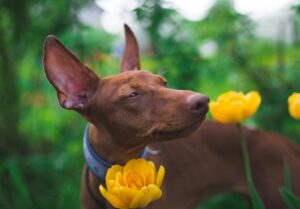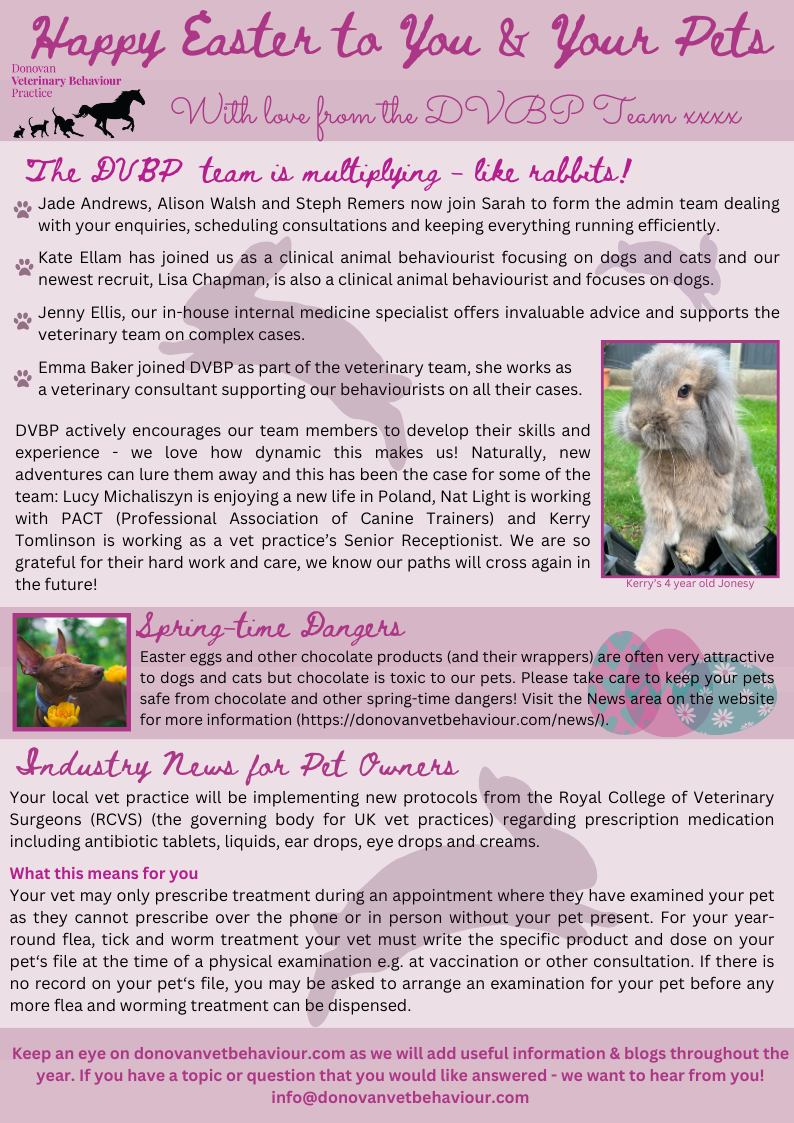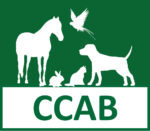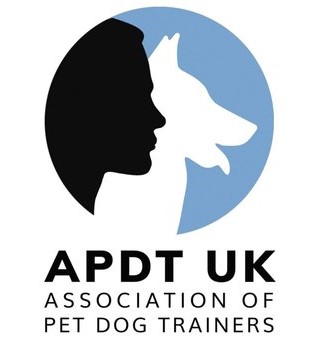
It’s spring-time, we’re unfurling from our winter isolation and hibernation and beginning to plan in social gatherings and exploring the countryside. But beware… there are dangers lurking!
Spring-time Flowers & Bulbs
Curious pets (especially young ones) may be interested in the protruding spring plants and their bulbs that are beginning to make an appearance with the warmer weather and they may chew or eat the spring flowers. These include snowdrops, crocus, daffodils and tulips which may be growing in the garden or be available in the home as cut flowers. These can cause gastrointestinal upset and some animals may require treatment to control vomiting and replace lost fluids.
Hot Cross Buns and Simnel Cake
Grape toxicity is linked with kidney damage in dogs. Eating grapes and their dried fruits (currants, raisins and sultanas) can result in sudden kidney failure and even death in dogs. The toxic substance in grapes is unknown, but dogs cannot metabolize tannins, flavonoids, and monosaccharides from grapes. Traditional easter cakes such as hot cross buns and simnel cake contain raisins or sultanas. Ingestion of even a small quantity of dried fruit can cause severe kidney failure. For more information on Grape poisoning, visit the Animal Poison Helpline (https://www.animalpoisonline.co.uk/)
Chocolate
As Easter approaches, some of us will be anticipating family gatherings which often involve tempting chocolate goodies and cakes, it’s hard to resist and it’s easy to forget that some things us humans enjoy so much are actually toxic to cats and dogs! Easter eggs and other chocolate products (and their wrappers) are often very attractive to pets. Please take care to keep your pets safe from chocolate and other spring-time dangers!
Chocolate contains a chemical called ‘theobromine’, which is toxic to dogs and cats. The darker and more bitter the chocolate the more theobromine it contains.
Dogs should not eat chocolate. If your dog has accidentally got hold of some, their risk will depend on their weight, the type of chocolate and the amount they have eaten.
What does theobromine do to dogs?
The half life of theobromine in dogs is about 18 hours. Theobromine primarily affects the central nervous system, cardiovascular system, and respiratory system, as well as having a diuretic effect. The first signs of poisoning in dogs include vomiting, haematemesis (vomiting blood), and polydipsia (increased thirst). In large enough amounts, theobromine can be fatal.
Although there is no specific antidote, supportive management includes induction of vomiting and administration of activated charcoal, oxygen, and intravenous fluids. The lethal dose of theobromine is reported to be 100-500 mg/kg of body weight in dogs.
What to do if your dog does eat chocolate?
You should monitor them closely and seek veterinary attention if they show any symptoms. Symptoms usually start within six to 12 hours, but could appear within one hour. If your dog has eaten chocolate, contact your veterinarian, an emergency veterinarian, or the Animal Poison Helpline (https://www.animalpoisonline.co.uk/)
What to do if your pet has hold of something dangerous
Your instinct might be to simply pry open their mouth and take away the item. Firstly, this technique can be dangerous as it puts you at risk of being bitten and could make the dog swallow or choke on the item. It can also increase the chance that the dog will become more possessive over items in their mouth in the future — it’s a recipe for resource guarding.
Secondly, don’t chase them around in an effort to get it back. Dogs love to play the ‘keep away’ game and chasing after the item increases its value in your dog’s mind. Some dogs will even swallow items if they think you’re about to take it away, which could cause them to choke or create an obstruction in their digestive tract. Instead, try one of these distraction techniques:
- Bend down and pretend you’ve found something ABSOLUTELY AMAZING on the ground. “Ooh and aaah” over it, maybe even pretend it’s something yummy and pretend to eat it. Dogs will often wonder what it is and come over and join you in investigating, dropping the item from their mouth in the process.
- Calmly walk into your kitchen, or whichever room where you store the dog treats or food. Make lots of noise while you open up the bag. Your dog will most likely follow you and know what’s happening once they hear that bag crinkle. Once they drop the item, toss the treat or piece of kibble in their food bowl. Quietly reclaim the item while they eat their treat and put it out of their reach.
- Grab one of your dog’s toys and make a big deal about playing with it, squeaking it and tossing it around. Your excitement over the toy should entice your dog to come over and want to play with you, dropping the other item on the way.
- In an emergency situation, and only if your dog is likely to respond, ring the doorbell to encourage your dog to drop what they’ve got and leave the room as this may give you enough time to control the situation.
These suggestions are for situations that need an instant response and we would recommend that you regularly work on more positive teaching methods for your dog such as the ‘drop’ and ‘leave it’ responses in preparation for such situations. Find out more about the one-to-one training sessions we offer at Donovan Veterinary Behaviour Practice.
Your pets don’t need to miss out
There are varieties of ‘pet chocolate’ available but be aware that although these won’t contain theobromine, they can still cause obesity. Whether you decide to give your pet a playful treat or a tasty treat, they’ll be happy! We’ve selected a number of toys to keep your Dogs and Cats entertained and away from your Easter eggs so everyone can be happy – visit our Links section to find out more.


 Here are some key traits to look for in a pet sitter:
Here are some key traits to look for in a pet sitter:


 Let’s spread awareness about dog theft prevention. Together, we can make a difference and keep our beloved companions safe from harm.
Let’s spread awareness about dog theft prevention. Together, we can make a difference and keep our beloved companions safe from harm.






